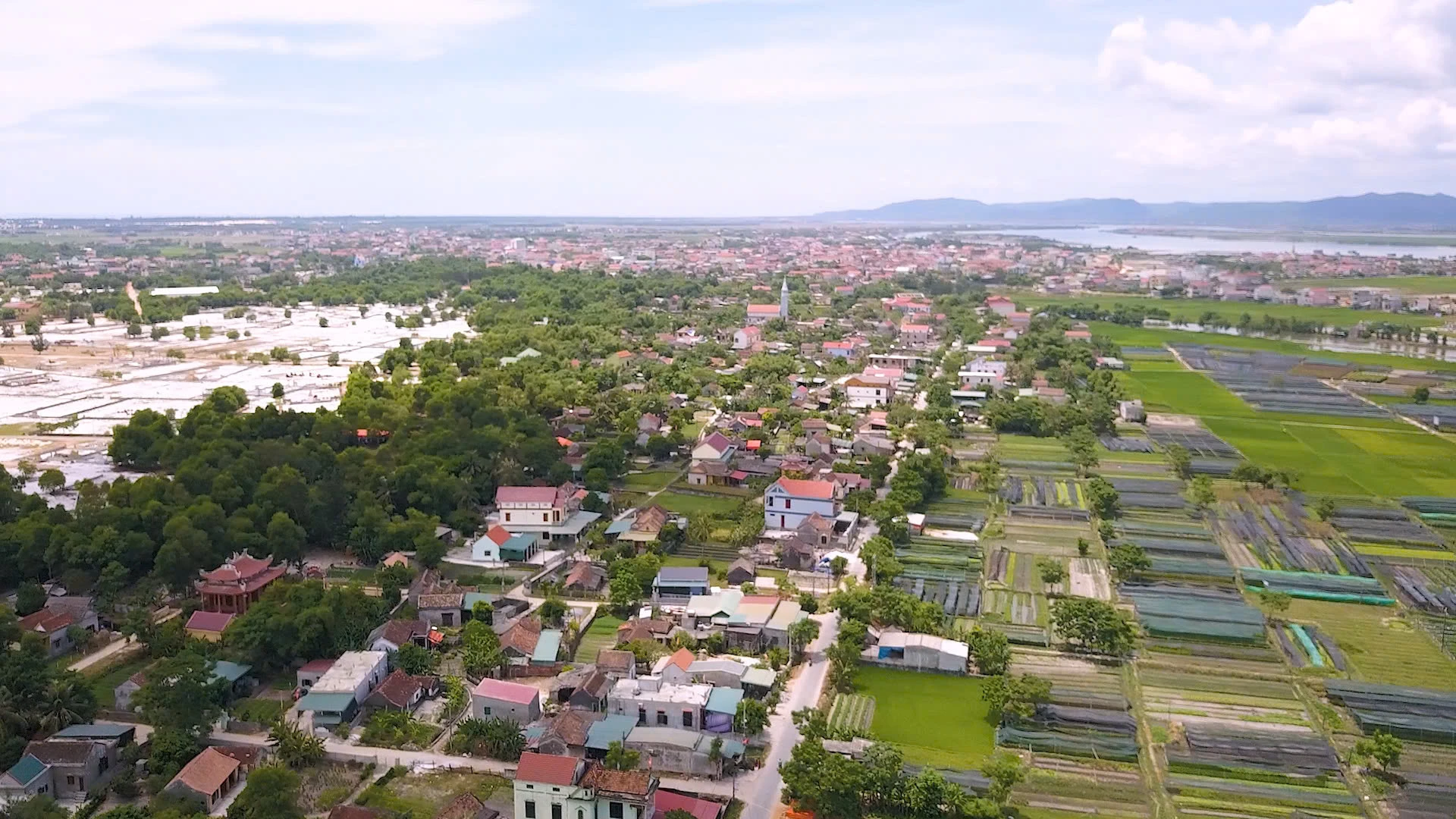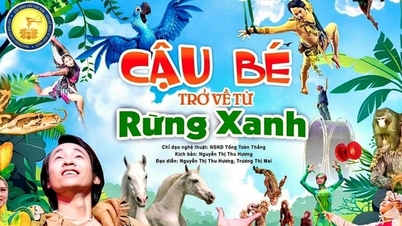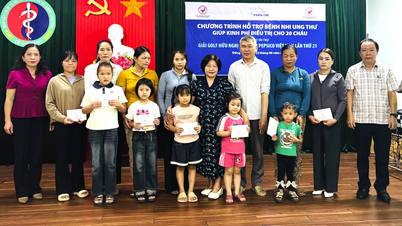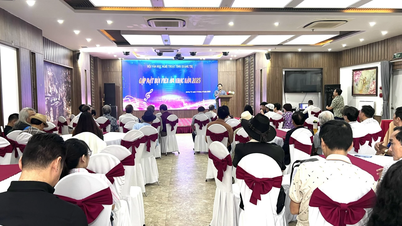I grew up with my mother's lullaby and the folk songs about the village that have been soothing over time: Tuong Son water is both clear and cool/Tuong Son road is sandy and easy to walk. I don't know when the village was founded, growing up I only heard the elderly tell me that Tuong Son land was founded by four ancestors with the surnames Tran, Ngo, Nguyen, Pham. They chose a piece of land with its back against the sand dunes, facing the fields and the river, which was favorable for farming and raising livestock. From the four ancestors, the closely-knit clans were formed, together cultivating the soul of a prosperous village.
At the village entrance there is a large puddle, called Ngoc Sao well, full of water all year round, even in the scorching summer it never dries up. The ancients said that the well was bottomless, and that in flood years dong leaves would rise from somewhere below the well. Now I think differently, Ngoc Sao well has an underground water source connected to a stream somewhere in the forest, so floods cause this phenomenon. Ngoc Sao well is crystal clear, gushing up from the sand, sweet and mild. The water flows into small streams, irrigating the fields. When we children came home from school, we scooped up some water and drank it, which was so cool and refreshing.
 |
| Tuong Son village (now in Ba Don ward) seen from above - Photo: HS |
In the middle and at the end of the village, there are two ancient square wells - called village wells. The wells are built with large stone slabs, covered with moss but the water is crystal clear. According to the elders, the wells date back to the Cham people. I don't know if it's true or not, but the water in the well is cool and sweet and never dries up. During drought years, the wells provide water for the whole village and the surrounding people. The village wells become a place for gatherings and community activities.
I remember the moonlit nights, when the whole village was quiet, the village well became cheerful and bustling. Groups of people carried two buckets of water, the buckets were lowered and pulled up, the sound of falling water mixed with the laughter of young men and women. And from the crowd, smooth, sweet songs arose, sometimes passionate, high and low like the heart of a girl, sometimes witty and cheerful of young men. The village well became a place for dating, a place where love affairs began, a witness to the "red flower time" of many young men who broke up with their lovers to take up arms and follow the call of the country. Now, the village well is still there, still meditating in the sky, as if embracing and missing the children of the village through many generations, taking refuge in all four corners of the world.
People say that old people often think about the past. Every time I stand and look at the village well or the river in my hometown, my heart is filled with many emotions. My hometown river is now much different from the past, both sides have been built with embankments, paved with bricks, creating a park, with a modern appearance. But the image of the old river still clings to me throughout my life. I remember clearly the summer afternoons, we children rushed to the river to bathe, our laughter filled the sky. On bright moonlit nights, everyone invited each other to go pounding the nets (beating the buckets), swimming in the cool water. On hot summer afternoons, diving with friends to catch clams and mussels, our hands wrinkled from soaking in the water but our eyes were still radiant.
The river still flows quietly, as if no months or years have passed. My hometown people still remember and carry with them stories about the river. The story goes that: In the past, the girls of Tuong Son village were beautiful, charming, familiar with housework, and good at trading, so many young men from other communes came to find out and marry them. One day, a man from Trung Thuan village came to ask for a wife from Tuong Son village. When the group arrived at Kenh Kia bridge, the girl's family came to welcome them. An elder stepped forward to greet them and then challenged them with a couplet: "Foot stomping, hand groping for the bald Kịa fish".
Hoi Kia is the name of the river that flows along the village; lon is the name of a fish with a flat, curved leaf shape. This parallel sentence is both contradictory and malicious. Everyone in the groom's party was confused when Mr. Nguyen Ham Ninh stepped forward from behind to improvise: "Mama next to, mouth holding goby fish of Khe Giang". Khe Giang is the name of a stream in Trung Thuan village, with many goby fish. A talented parallel sentence, both humorous and full of literary quality. The bride's family admired it, and the wedding was held grandly. The story has been passed down from generation to generation, becoming the pride of my hometown every time it is mentioned.
My village does not have high mountains, but has immense sand dunes and forests to block wind and sand; standing tall and proud through stormy seasons, protecting the village through many wars. During the years of resistance against French colonialism, my people followed Uncle Ho's call: "Whoever has a gun, use a gun, whoever has a sword, use a sword...", united as one, fenced the village to fight, establishing glorious feats with the people of the whole country. During the period of resistance against the US, my village became an important transit point of Gianh ferry; the ancient stone trees, the myrtle forests of Xom Loi Mieu, Tram Nghieng, and Troc Let were places to hide weapons, stopping places for soldiers going to the South to fight. The forests and sand dunes of my hometown witnessed many soldiers having their memorial services before leaving. My village, like many other villages on both banks of the Gianh River, became the focus of attacks by American planes and warships. The Kia Canal Bridge connecting National Highway 12A to the Truong Son route, every time it was destroyed by American planes, people from my hometown, Ba Don area, volunteered to demolish their houses to build a bridge with the slogan: "If the car has not passed the house, we will not regret it. If the road is not cleared, we will not regret the blood and bones"...
The country is peaceful and unified . The countryside is beautiful, rich, and renewed. Now, implementing the policy of rearranging and reorganizing administrative units at all levels, my village is no longer a separate commune or ward, but is integrated into a larger area - the beginning of a new era of development. But even though the name has changed, in the hearts of every person in my hometown, Tuong Son village is still the place where the soul is anchored. It is the place where every step away is remembered, always filled with love and nostalgia; always preserving the quintessence of many generations and will continue to resonate in the folk songs that future generations will continue to carry on!
Tran Dinh
Source: https://baoquangtri.vn/van-hoa/202509/noi-neo-dau-tam-hon-d7a4968/


![[Photo] Unique Phu Gia horse hat weaving craft](https://vphoto.vietnam.vn/thumb/1200x675/vietnam/resource/IMAGE/2025/10/10/1760084018320_ndo_br_01-jpg.webp)


![[Photo] Standing member of the Secretariat Tran Cam Tu works with the Standing Committee of the Party Committee of the Ministry of Health](https://vphoto.vietnam.vn/thumb/1200x675/vietnam/resource/IMAGE/2025/10/10/1760079818773_image-4-6972-jpg.webp)

![[Photo] "Exposing letters" in the flood center of Lang Son](https://vphoto.vietnam.vn/thumb/1200x675/vietnam/resource/IMAGE/2025/10/10/1760080117518_ndo_br_z7101324112737-07cd4d1c01801a8ccf4ae0cbaf31c4a3-507-jpg.webp)





















































![[Photo] President Luong Cuong presents decisions on conferring titles and appointing Vietnamese Ambassadors](https://vphoto.vietnam.vn/thumb/402x226/vietnam/resource/IMAGE/2025/10/10/1760082105623_image-1.jpeg)



































Comment (0)